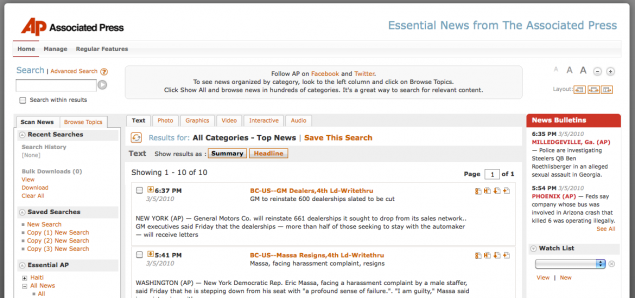Biz: More thoughts on Attributor and the news copyright police
- After hearing from Rich Pearson of Attributor, we think it’s at least fair to articulate what we think a content-licensing agreement should be like for bloggers. Because it seems like, while Attributor has a good point (and is apparently following a don’t-be-evil pathos), their business model comes across almost as a debt-collector role regarding the copyright of content. As far as content-charging goes, what we’d like to see is a storefront approach as a way to add value to the proposition. A bit of explanation:
How newspapers get wire content:
- This is AP Exchange. We have access to this resource due to the fact that we have a day job. We don’t use it (or link to any AP content, preferably) on ShortFormBlog because recent statements from the wire service have raised a lot of red flags for us about the usage of its content on blogs. Anyway, your mom-and-pop bloggers don’t have (and may not need) access to something this elaborate, but there are things that many bloggers could really use – budgets of upcoming stories (allowing for planning, not reaction), high-resolution photos, and graphics in vector format which can be easily reworked. Unfortunately, it requires a huge contract and newspapers have to give years-in-advance notices if they choose to quit the wire service. Most blogs aren’t that big – unless you’re HuffPo, you can’t afford it.
Business model points of comparison:
- » Photoshop Elements: Not everyone needs the full version of Photoshop, an incredibly complex product with a lot of knobs to twiddle. So Adobe created Photoshop Elements, which offers many of the features at a cheaper price. Simpler, cheaper – that’s what we’d suggest.
- » Lala/Spotify: iTunes isn’t exactly the model we’d suggest for this. An all-you-can-eat model like Spotify is nice, while an ultra-cheap micropayment distribution model like Lala might be ideal. Many news stories don’t have a ton of currency beyond the first day.
- » Typekit: Typekit, which is trying to do something similar for typography, has a very polished interface on the developer’s end which makes it incredibly easy to find the right font to use. Their use of javascript is a little annoying, but ultimately, it strikes a good balance between making rights-holders happy and giving Web site owners more options.
What we’d like to see:
- one We think bloggers need an interface for content-gathering on a wire service, something that they could use as a resource just like Google News and Twitter.
- two We think Automattic or Six Apart (or Publish2, even), which already have significant ties to the blogging community, would be great choices to run a site like this.
- three And – this is the important part – it needs to be done well, in a way that doesn’t talk down to them, that emphasizes quality, not assuming the worst of its users.
Why we think Reuters will come up with this:
- I believe in the link economy. Please feel free to link to our stories — it adds value to all producers of content. I believe you should play fair and encourage your readers to read-around to what others are producing if you use it and find it interesting.
- Thomson Reuters President of Media Chris Ahearn • From an article he wrote back in August. We wrote about it then, too, and we think it suggests that Reuters will figure this out before the Associated Press. The AP is more beholden to its newspaper partners, and companies like News Corp. and Tribune Corp. have too many interests in their own products. We think offering diverse options would be great for bloggers and would help take much of the stigma away from what they do. But not everyone’s there, sadly. Fingers crossed that the concept behind Attributor is a good first step, not a bad last one. source

